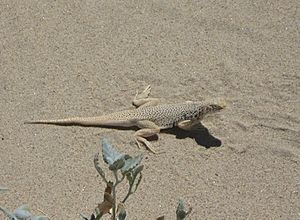Mojave fringe-toed lizard facts for kids
Quick facts for kids Mojave fringe-toed lizard |
|
|---|---|
 |
|
| Conservation status | |
| Scientific classification |
The Mojave fringe-toed lizard (Uma scoparia) is a special kind of lizard. It is medium-sized and usually white or grayish with black spots. These lizards are active during the day, which means they are diurnal. They belong to a group of lizards called Phrynosomatidae.
This lizard is perfectly suited for dry places. You can mostly find it in the sandy areas of the Mojave Desert. A cool thing about fringe-toed lizards is the special scales on their back toes. These scales look like fringes and help them move easily on loose sand.
What They Look Like
The Mojave fringe-toed lizard has a flat body and smooth skin. Its skin color helps it blend in with its surroundings. It can be a tannish-white or grayish-white. You might also see small black spots on its back.
On its belly, this lizard has up to three crescent-shaped markings on its throat. These are a special sign of the Mojave fringe-toed lizard. It also has dark bands on its tail and dark spots on the sides of its belly. When it's mating season, the dark spots on its belly turn pink. Its whole underside also becomes a pale yellow.
The lizard's tail is about the same length as its body. The whole lizard can grow to be around 7 inches long.
Male lizards like to protect their space. They walk around the edges of their home area. They also do special displays to show they are in charge. These displays are more about finding a mate than protecting food. Female lizards don't protect their territory in the same way. Instead, they protect a specific spot.
Life Cycle
Adult Mojave fringe-toed lizards usually hibernate from November to February. They do this by burying themselves about a foot deep in the sand. Younger lizards hibernate closer to the surface. Some young lizards don't hibernate at all and stay active all year.
In March and April, these lizards are active for fewer hours. This is because the Mojave Desert is still cooler then. Other lizards in the Uma family are more active during these months.
Mojave fringe-toed lizards become old enough to have babies in their second year. Their mating season is usually in late spring. How much rain falls can affect how many babies they have. Females usually lay 1 to 5 eggs per mating season. On average, they lay 2 or 3 eggs. These eggs hatch in September.
These lizards do not move to different areas during different seasons. They probably bury their eggs in the sand, just like other lizards do. More young lizards are born after wet winters. This is likely because there are more plants and insects for them to eat then.
What They Eat
These lizards mainly eat small creatures without backbones, called invertebrates. They find these near the surface of the sand. Their favorite foods include ants, beetles, scorpions, hemipterans (like true bugs), spiders, antlion larvae, and grasshoppers.
They also eat plants, such as seeds, leaves, flowers, and grasses. As summer comes and yearly plants become harder to find, their diet changes. They start eating more insects and fewer plants. Sometimes, they have even been seen eating smaller lizards of other types. They might also eat smaller lizards of their own kind.
During mating season, their eating habits can change. Males have been seen eating plants and insects only in the morning. Females and young lizards, however, eat these foods throughout the whole day.
Where They Live
The Mojave fringe-toed lizard lives in several places. You can find them in Inyo County, Los Angeles County, Riverside County, and San Bernardino County in California. They also live in western Arizona, in La Paz County.
Most of these lizards live in areas with fine sand. This includes dry lake beds, desert washes, and hillsides. They can live anywhere from sea level up to about 3000 feet high.
Dangers They Face
The Mojave fringe-toed lizard has several animals that hunt it. These predators include roadrunners, badgers, loggerhead shrikes, coyotes, and different kinds of snakes.
These lizards are very good at blending in with their surroundings. They can also hide under the sand. But many have been harmed or killed by off-road vehicles. These vehicles are used for fun in the desert. Off-roading also damages the bushes and plants. These plants are important because they provide food and shelter for the lizards. Since 1999, off-roading has tripled in sandy areas. This has led to more lizard deaths and fewer lizards overall.
Other things that threaten their homes include pollution from military activities. City growth, dirty air, and global warming also cause them to lose their habitat.


